Norway
one of the most equal countries in relation
to income in the developed world
researched
Possible factors of equality
History
Income
Taxation system
Social welfare
Housing
Education
Healthcare
Effects of equality
Housing/Homelessness
Education
Social mobility
Healthcare
Community life and social relationships
Mental health
Drug use
Obesity
Teenage pregnancy
Life expectancy
Violence book
Environment
Waste production
Pollution
Cycling
Deforestation
Sources
Life in Norway
BBC
Equality trust
Book: The Spirit Level by Richard Wilkinson and Kate Pickett
Wikipedia
History
8th Century AD The beginning of the Viking era
Perhaps the most famous period in Norwegian history, the Viking Age was a period of expansion not just for Norway, but the whole Nordic region.
Far from just barbaric, axe-wielding invaders, the Vikings created complex social institutions, oversaw the coming of Christianity to Scandinavia and left a major impact on European history through trade, colonization and far-flung exploration.
The first record of the Vikings was the late 8th-century raid on Lindisfarne, an island off the northeast coast of England.

Vikings cruising the oceans.
900-1030 From Vikings to Christianity
Early Vikings saw Christianity as a heretical threat to their own pagan beliefs. Christian monks and missionaries were active in Scandinavia throughout the Viking Age, but it took until the era of Olav Tryggvason (963-1000) for the tide to begin to change. Following Tryggvason’s death, it was Olav Haraldsson who began to pass church laws, destroyed pagan temples, build churches and appoint priests.
By 1030 Christianity was adopted as the main religion.
The 14th century is described as Norway’s Golden Age, with peace and increase in trade. Until in 1349, the Black Death spread to Norway and within a year killed a third of the population.
In 1380 Olaf Haakonsson inherited the thrones of both Norway and Denmark and created a union, the start of a long period of political alliances and wars between the Scandinavian countries.
1817 Norway as an independent nation
The economy suffered as Denmark–Norway backed France in the Napoleonic Wars and soon Sweden took an interest in Norway.
Following the Battle of Leipzig in 1813, Norway was ceded to the king of Sweden. The Crown Prince of Denmark-Norway and resident viceroy in Norway, Christian Frederik, however, began a Norwegian independence movement not happy with the cessation of Norway to Sweden.
He traveled to Trondheim to gain support for his person, and then assembled twenty-one prominent citizens in February 1814 to discuss his plans.
They rejected a new absolute monarchy and advised him instead to convoke a constituent assembly to draw up a liberal constitution and decide the form of government.
Representatives from the entire country were elected to meet. The 112 members of the Constituent Assembly gathered and, after six weeks of discussion, concluded the work on the Constitution of Norway on 17 May 1814. Power would be split between the king — a position to which Christian Frederik was appointed — and the Parliament of Norway.
Just weeks after the signing of the constitution, King Carl Johan of Sweden invaded Norway and due to economic troubles, Norway accepted to enter a personal union with Sweden on equal terms, while Sweden accepted the Norwegian Constitution and separate institutions in both states.

Signatures on the original Norway’s Constitution document from Eidsvoll signed 17 May 1814.
In early 1905, Christian Michelsen formed a coalition government in Norway consisting of liberals and conservatives, whose only stated objective was to establish a separate Norwegian corps of consuls. The law was passed by the Norwegian parliament. As expected and probably as planned, King Oscar II ( King of Sweden) refused to accept the laws, and the Michelsen government resigned.
When the king declared himself unable to form a cabinet under the present circumstances, a constitutional crisis broke out on 7 June 1905.
Later that day, the Storting voted unanimously to dissolve the union with Sweden, taking the line that Oscar had effectively abandoned his role as King of Norway by refusing to appoint a replacement government.
Following some months of tension and fear of war between the neighboring kingdoms – and a Norwegian referendum held on 13 August which overwhelmingly backed dissolution (only 184 people voted for an union) – negotiations between the two governments led to Sweden’s recognition of Norway as an independent constitutional monarchy on 26 October 1905.
In 1913, Norway became the second country in Europe after Finland to give women the vote.
On the photo are the board members of the Norwegian National Women’s Council (LSKF) in 1904. Karen Grude Koht, Fredrikke Marie Qvam, Gina Krog, Betzy Kjelsberg and Katti Anker Møller. The LSKF was founded as a protest to the suffrage reform of 1898, when male suffrage was achieved, while women were left out.
The year after, the members put forward a demand of women suffrage with 12 000 names for the parliament. In 1905, the organisation supported the dissolve of the union with Sweden. From 1906, it was a part of the International Council of Women

First meeting of the National Women’s Council (1904). Left to right: Karen Grude Koht, Fredrikke Marie Qvam, Gina Krog, Betzy Kjelsberg and Katti Anker Møller
1940-1945 Although Norway adopted its policy of neutrality from 1905 in WWI and II, Forces of Nazi Germany occupied Norway from the beginning to the end of World War II.
Age of oil
In 1969, oil was discovered in the Ekofisk field, which would eventually become one of the largest oil fields in the world. The emerging industry not only created jobs in production, but a large number of supply and technology companies were established.
High petroleum taxes and dividends from state-run Statoil earned the government significant revenues – and continues to do so.
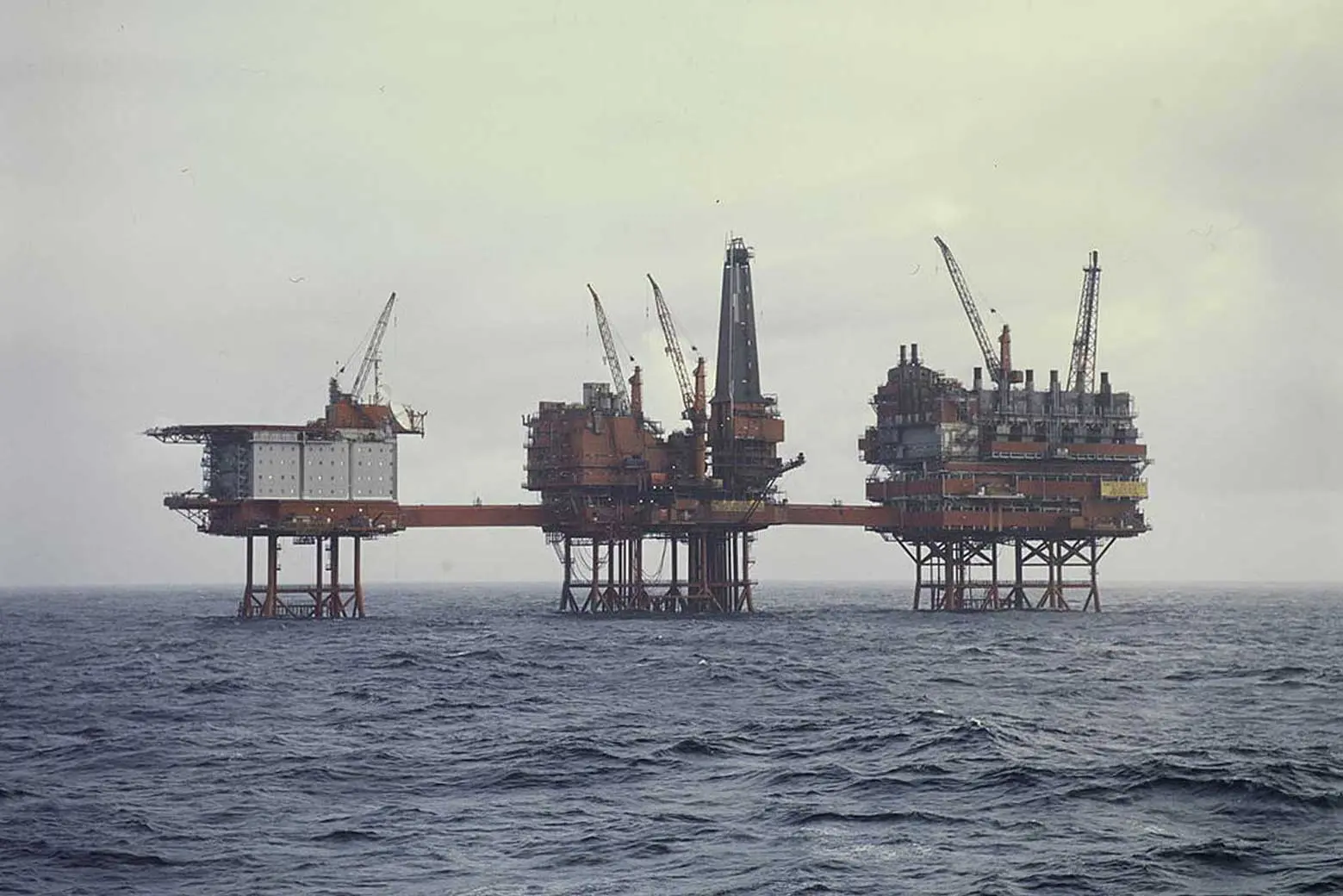
Norwegian oil field in the North Sea.
Income
Norway is among one of the most equal countries in the world.
Looking at income inequality and comparing the share of income received by the highest-income people, the following graph shows how the size of income differences varies from one developed country to another.
The length of the horizontal bar shows how much richer the richest 20 percent of the population is in each country compared to the poorest 20 percent. Norway is at the top of the chart where the richest 20 percent get less than 4 times as much as the poorest.
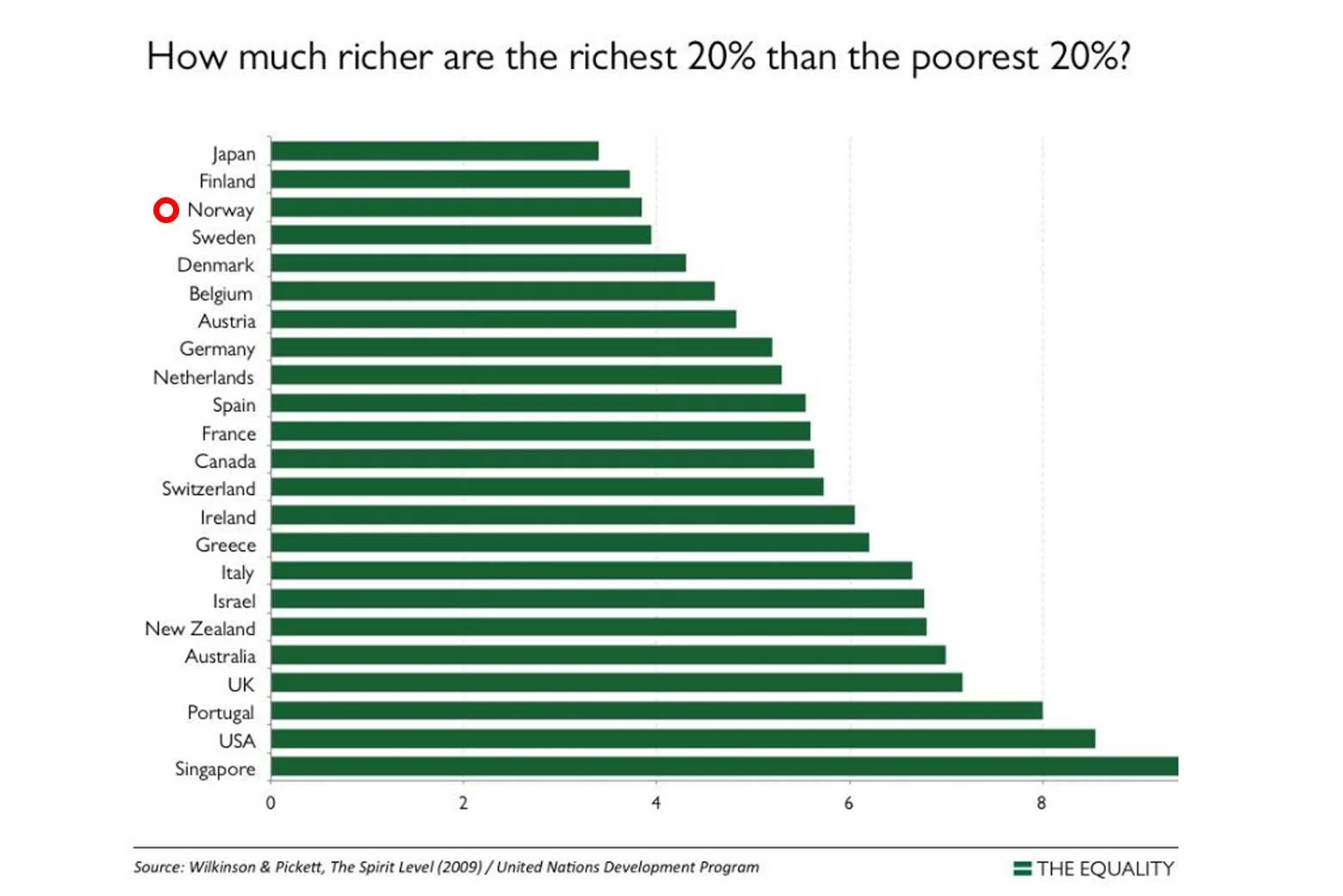
Taxation system
Income tax is split into a base rate and a step tax, to allow for progressive taxation. The base rate of income tax in Norway is 22%.
Corporate taxable profits (ordinary income) are taxed at a flat rate of 23%.
Social welfare
The following chart shows Norway’s public social spending and that the total expenditure on social protection benefits in Norway is high in comparison to other OECD countries. Norway spends nearly 25% of its revenues for social purposes.

Housing
The chart clearly depicts that the emphasis remains on a homeownership model. Public housing is therefore being provided to the most vulnerable who feel the direct impacts of housing shortages and long waiting lists.
Norwegian social housing policy changed in the period after the Second World War. In the initial period, with its housing shortages, social housing accounted for most households. The main element was subsidised new production of affordable housing. When most of the population had secured good and affordable housing, social housing targeted the most vulnerable groups that satisfied the means testing and the marginal groups that were at risk.
A combination of population growth, low interest rates, general optimism and easy access to credit has supported high housing demand and increasing house prices.
In recent years, Norway has seen a greater emphasis on targeted social housing policy. Social housing is a rather marginal system helping people with special and severe problems through public housing. Public renters are faced with little possibility of escaping a problematic situation and becoming part of the homeowner majority. This creates tensions between a general housing policy promoting home ownership and a targeted social housing policy offering housing through the public sector.

Chart showing percentage of owning properties and renting by citizens of various countries in Europe.
Education
The majority of Norwegian universities and state university colleges are publicly funded and the Norwegian government considers access to higher education for all to be an important part of the Norwegian society. Thus, as a rule, Norwegian public institutions do not charge tuition fees.

A group photo of international students in Norway, Stavanger.
Healthcare
Health spending per capita in Norway has grown steadily over the past decade. At EUR 4 459 in 2017, it is about two-thirds higher than the EU average. Health spending accounted for 10.4 % of Norway’s GDP, also above the EU average of 9.8 %.

Norway’s health expenditure.
Effects of equality
Housing/Homelessness
The number of homeless people in Norway has dropped from 6,259 in 2012 to 3,909 in 2016 (EOH, 2017).
The most important explanation for the sharp decline in the number of homeless people is long-term and broad focus on residential social work and the development of residential social skills. Norway has had a residential approach in the work of homelessness. This means that homelessness is understood as a housing problem, not primarily or solely as a social problem, and the provision of housing with or without follow-up is considered essential to prevent and reduce homelessness.
In comparison with the UK where it is estimated 320,000 people are homeless in the UK, according to the latest research by Shelter (4 Dec 2019) which is one homeless person per 201 people, in Norway there are 3909 homeless people (2017) which is one homeless person per 1370 people.
Education
In terms of the quality of the education system, the average student scored 504.3 in reading literacy, maths and science in the OECD’s Programme for International Student Assessment (PISA), slightly higher than the OECD average of 486.

PISA Worldwide Ranking – average score of math, science and reading.
Social mobility
Despite having data for only 8 countries, the relationship between intergenerational social mobility and income inequality is very strong. The graph shows that countries with bigger income differences tend to have much lower social mobility. Norway is on the top of this graph which is also linked to the public expenditure on school education which is about 97.8%. This is likely to have a substantial impact on social differences in access to higher education.
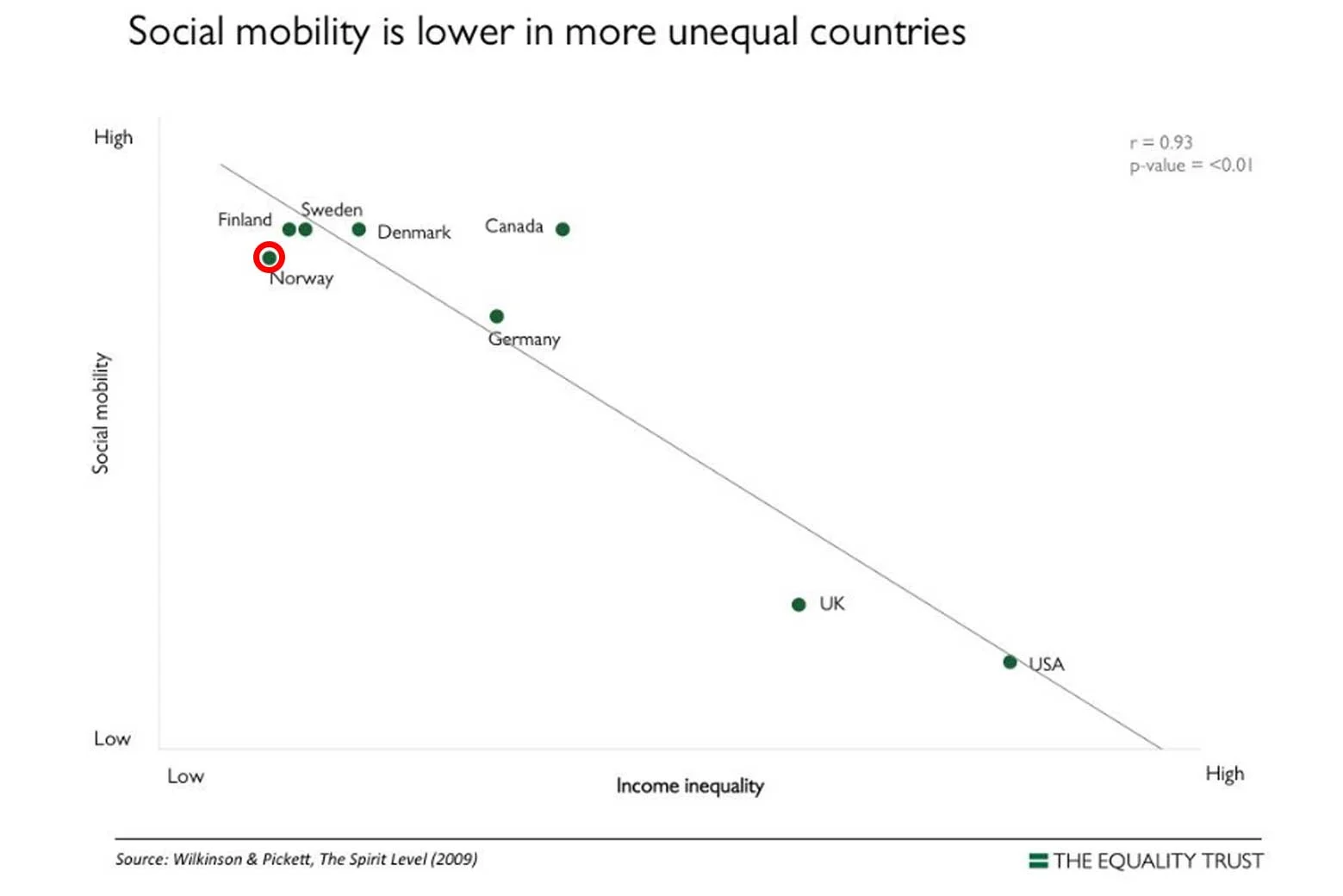
Social mobility chart.
Healthcare
Community life and social relationship
In Norway, about 64% of the population believe that other people can’t be trusted and 94% of people believe that they know someone they could rely on in time of need.
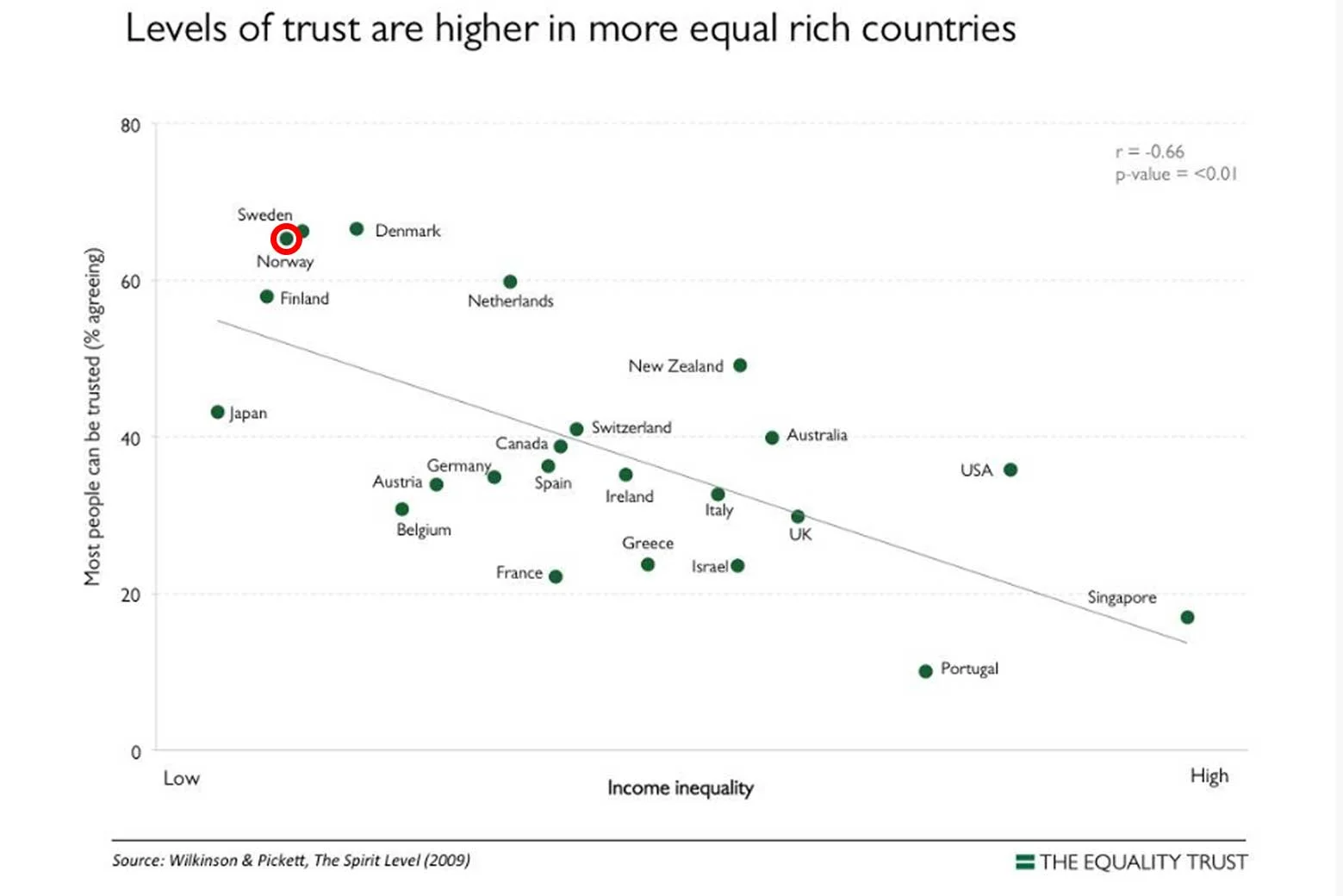
Trust chart.
Mental health
Norway is ranked among the world’s top ten countries in terms of the happiness of its population, according to an international survey (World Happiness Report 2018)
Nevertheless, mental disorders are prevalent but in comparison to other countries, the number of psychiatrists per 100 000 population ranges from 48 per 100 000 in Norway which shortens the waiting list if needed. Whereas the median number of psychiatrists is only 10 per 100 000 population in many other countries.

Mental health.
Drug use
In 2015, the Norwegian government presented a new action plan addressing substance use and addictions that comprises and prioritises activities for prevention, early intervention, treatment and aftercare for individuals with substance abuse problems.
In Norway, the latest average drug-induced mortality rate among adults (aged 15-64 years) was 75 deaths per million in 2016. Considering developments between 2003 and 2016, and the gradual population growth during the observed period, the trend is considered stable or slightly decreasing in terms of rate per capita.
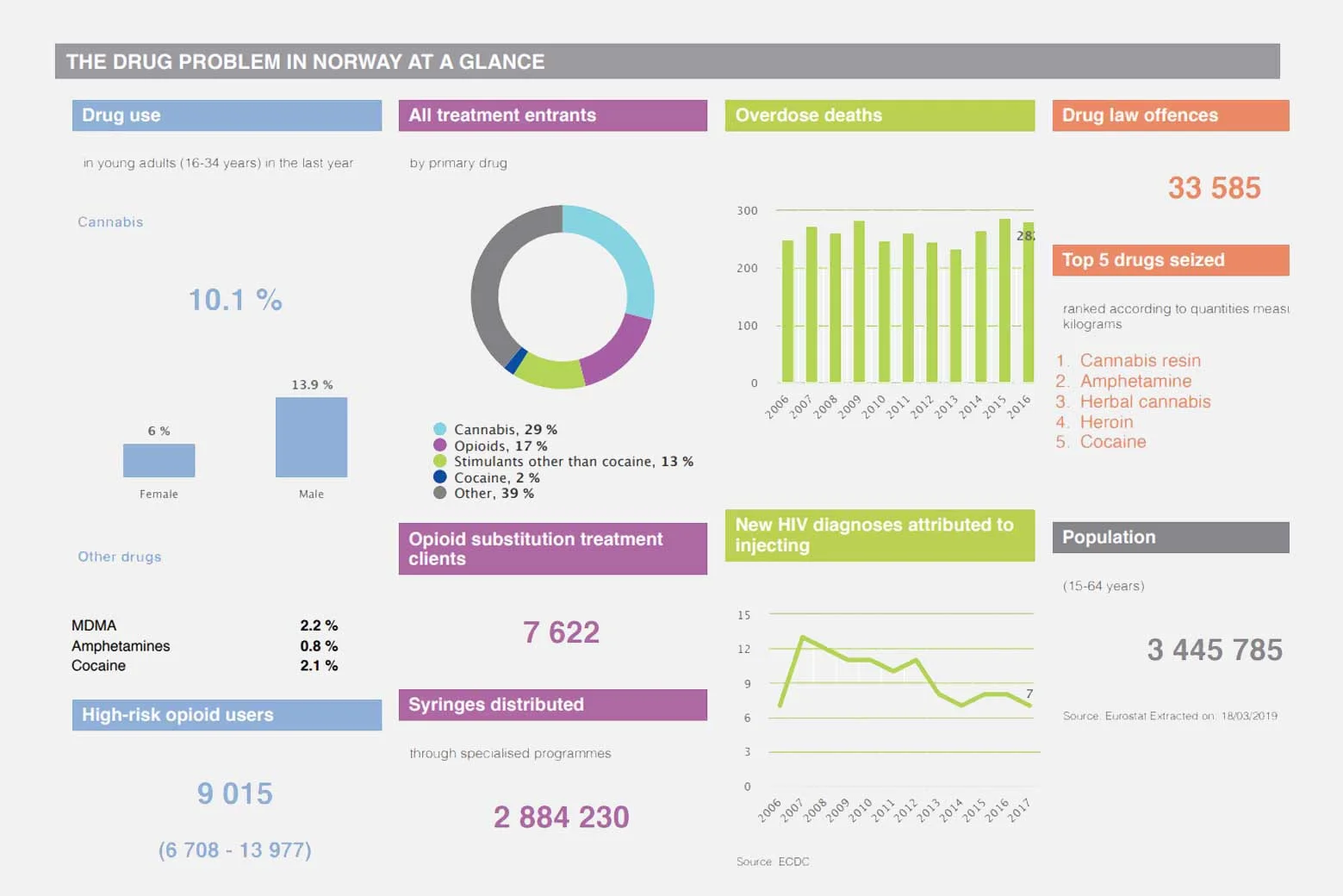
Chart of the drug problem in Norway at glance.
Obesity
The graph shows that levels of obesity tend to be lower in countries where income differences are smaller. In the USA, just over 30 percent of adults are obese; whereas in Norway only about 11% of adults are obese.
The obesity rate for adults also remains below the EU average, although it increased from 9 % in 2005 to 14 % in 2017. However, child obesity is on the rise.
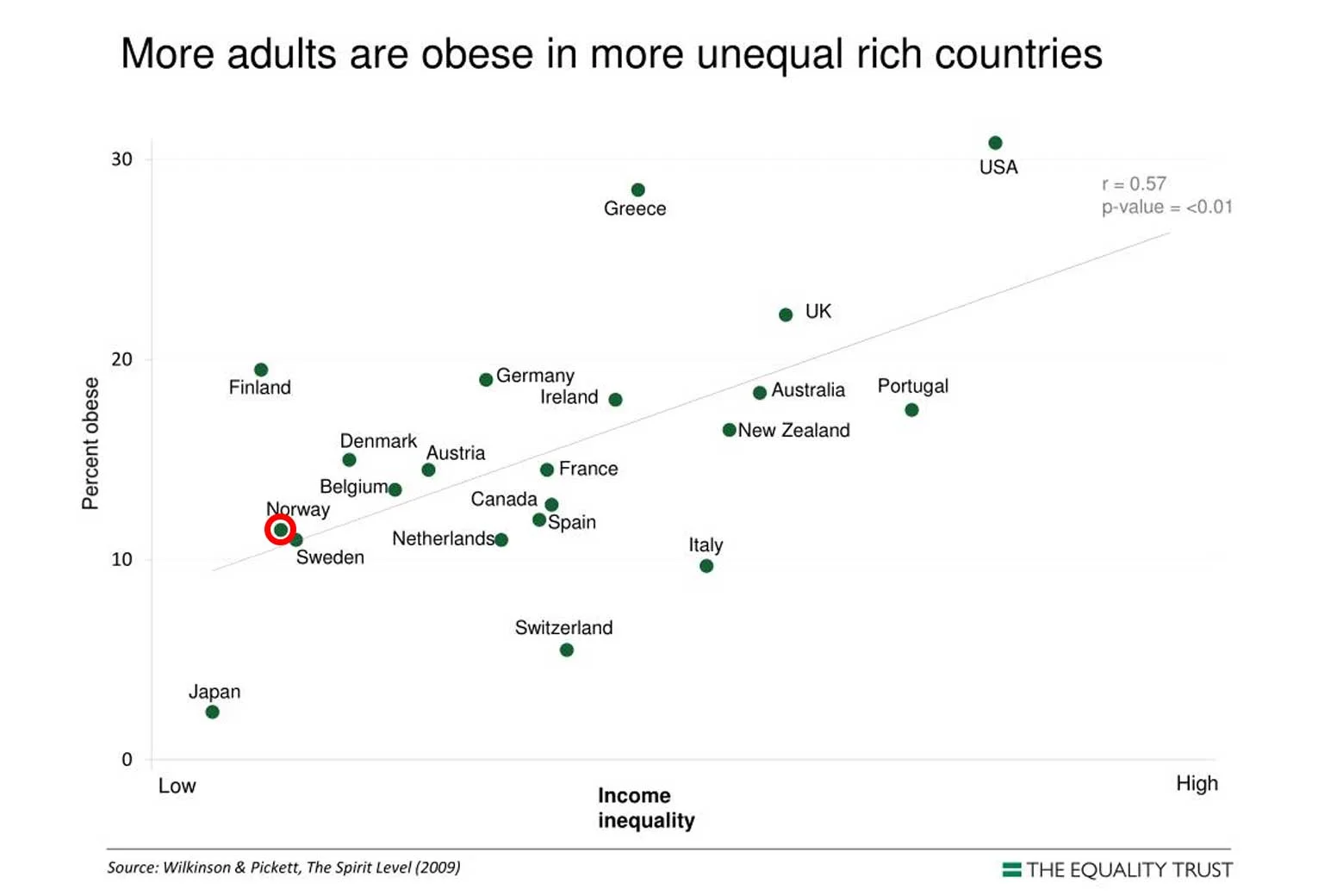
Obesity chart.
Teenage pregnancy
Norway is among the countries at the bottom of the charts when it comes to teenage birth where the teenage birth rate lays slightly higher than 10% (per 1000 women aged 15-19). The graph shows that teenage pregnancy is linked to income inequality.
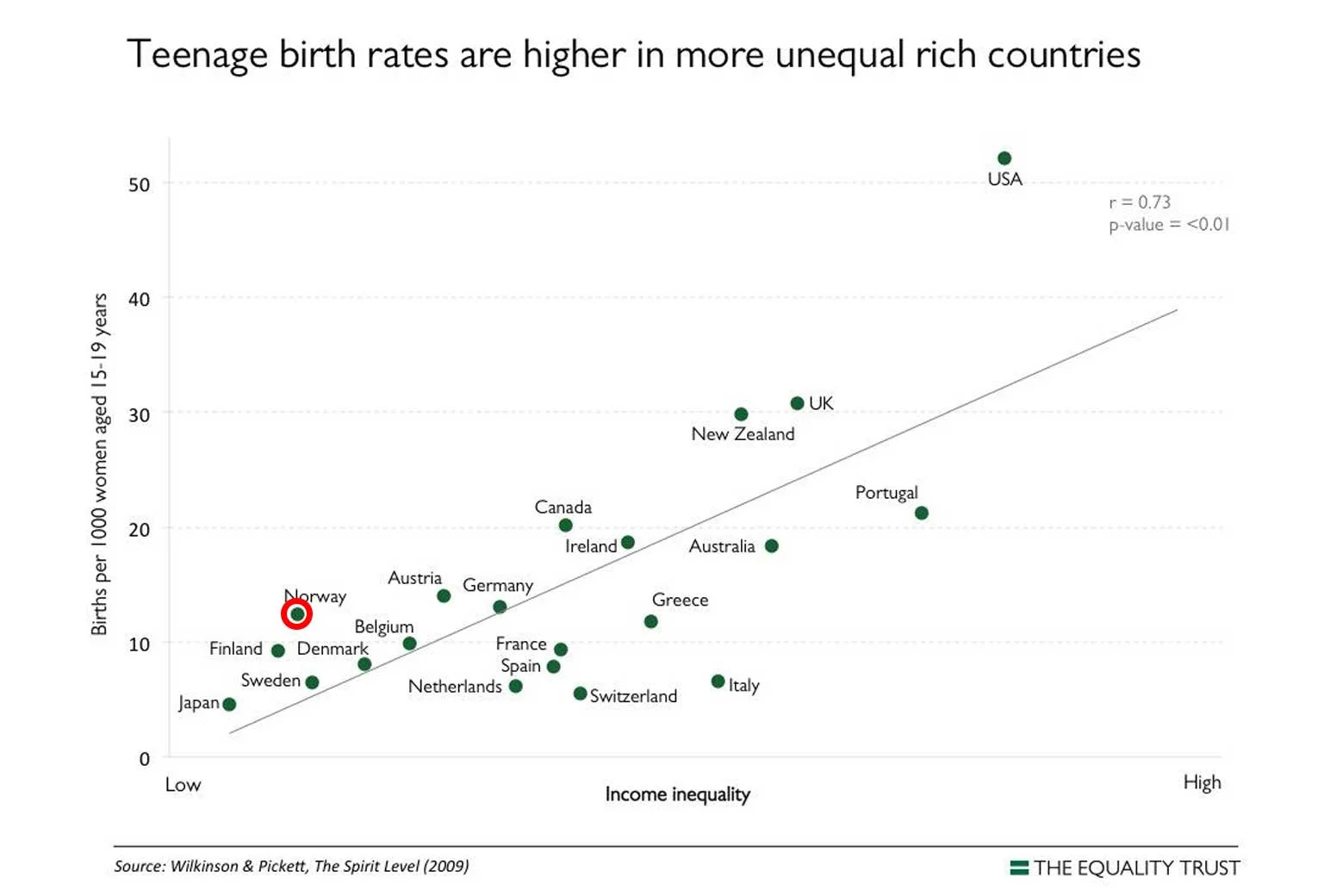
Teenage birth chart.
Life expectancy
Life expectancy at birth for the whole population in Norway stands at almost 83 years, three years above the OECD average of 80 years.
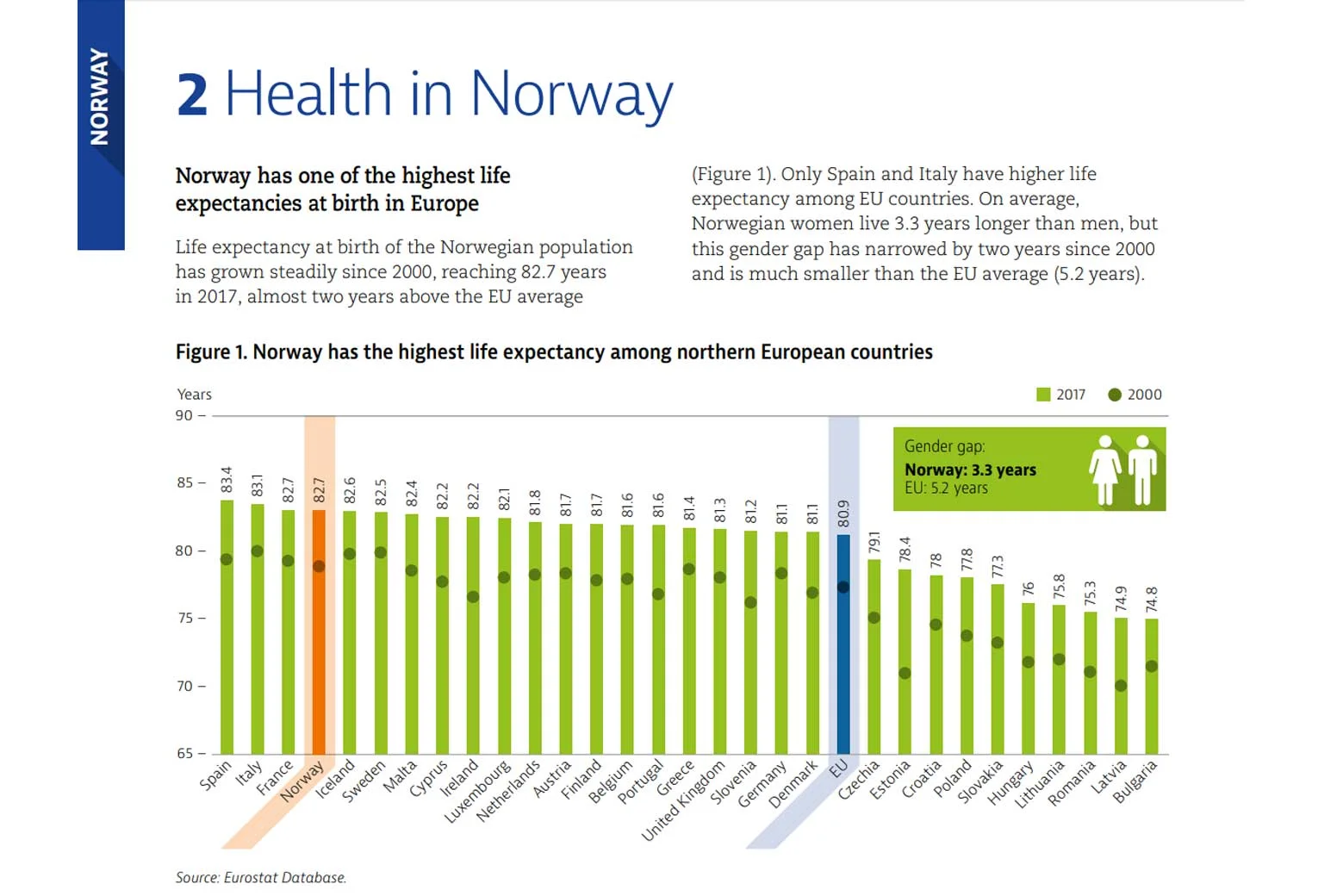
Life expectation chart.
Violence
The graph shows the international homicide rates are related to income inequality. Norway’s homicide rate is below 10%.
In Norway, there are also less people in prison with a rate of less than 55 per 100,000. In comparison with the USA which rate lays by 124%.
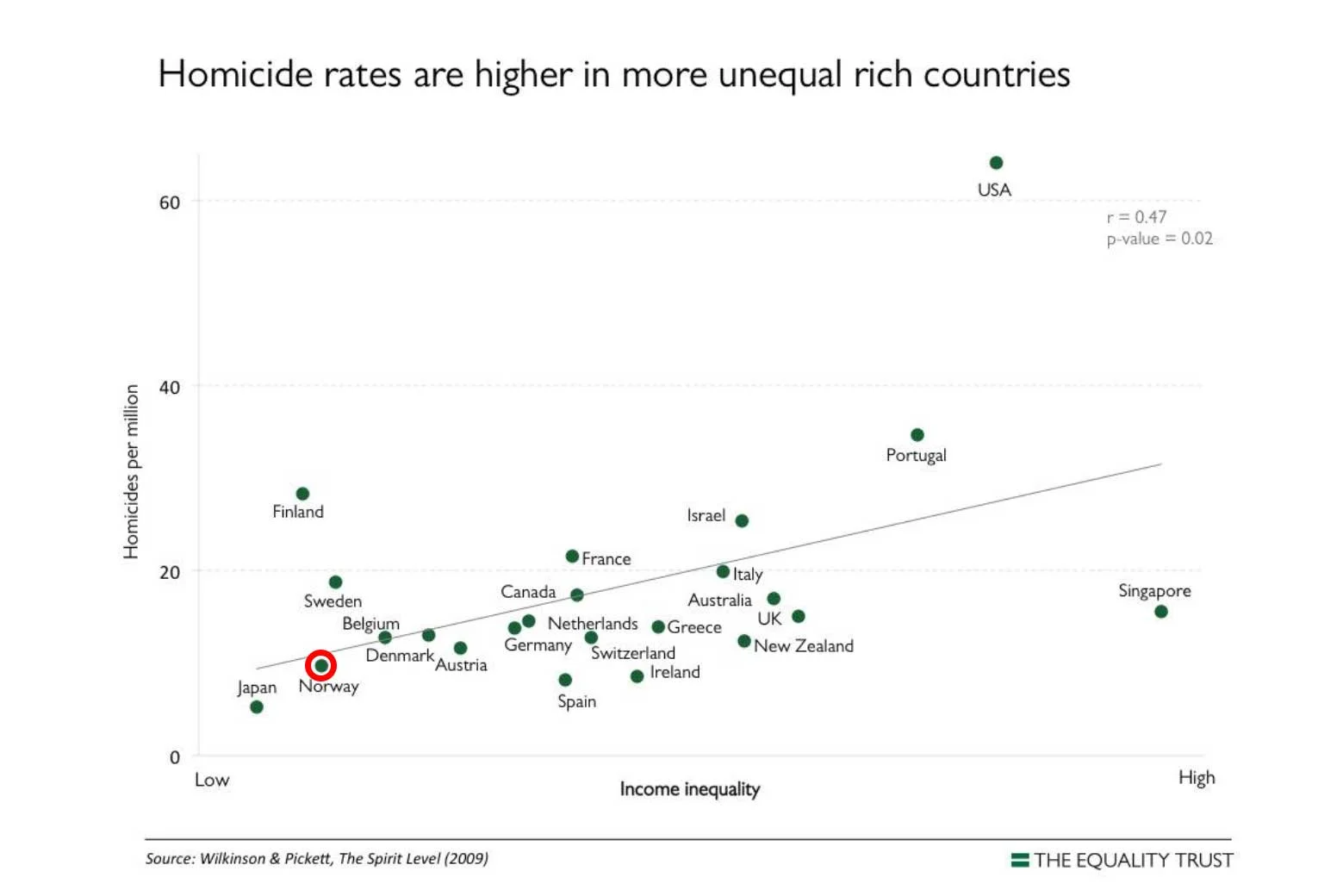
Homicides chart.
Environment
Waste production
Municipalities handled 2.2 million tonnes of household waste in 2018, less than in the previous years. On average, each inhabitant generated 421 kg of household waste in 2018 which also considers a decrease compared to the years before.
The graph shows that Norway is among the leading countries in relation to recycling, energy recovery and landfill restrictions.

Recycling, energy recovery and landfill per country in 2018 chart.
Pollution
The long-term World Health Organisation Air Quality Guidelines (for PM2.5 (Particulate matter (PM) is a term used to describe the mixture of solid particles and liquid droplets in the air) PM2.5 means the mass per cubic metre of air of particles with a size (diameter) generally less than 2.5 micrometres were exceeded at 69 % of the stations (958) located in all of the reporting countries, except Estonia, Finland and Norway. They did not report any concentration above.
Cycling
- People: 4,943,000
- Bicycles: 3,000,000
- Cyclists: 60.7%
In Norway 4% of all trips are made by bike.
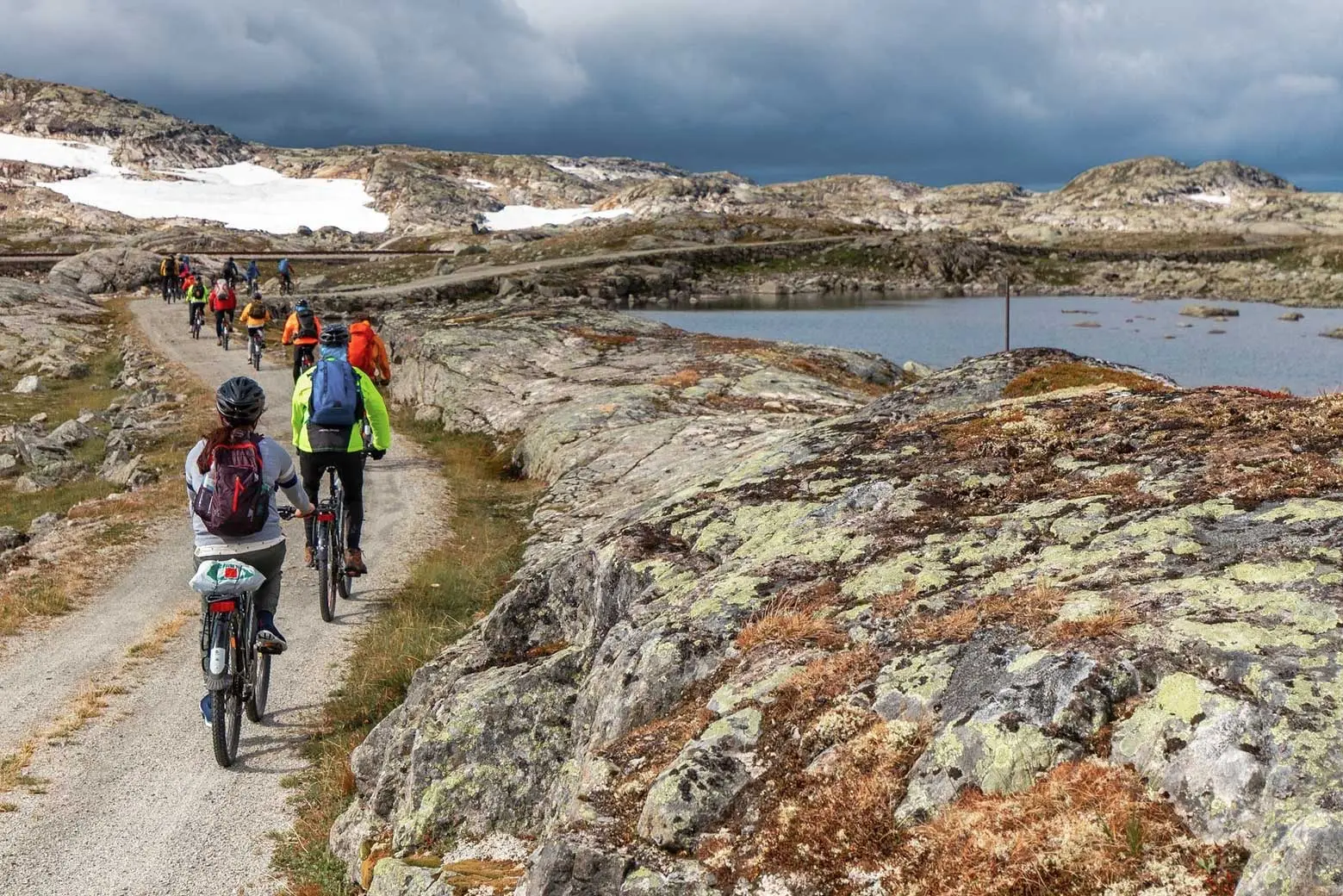
Cross country cyclists crossing mountains in Norway.
Deforestation
So far, Norway is the only country to do something towards this pledge that’s drastic enough to make a difference. They have become the first country in the world to ban deforestation. The Norwegian Parliament pledged that the government’s public procurement policy will be deforestation-free. By becoming the first country in the world to make such a large-scale move against deforestation, Norway is setting an example for other countries to consider similar policies.
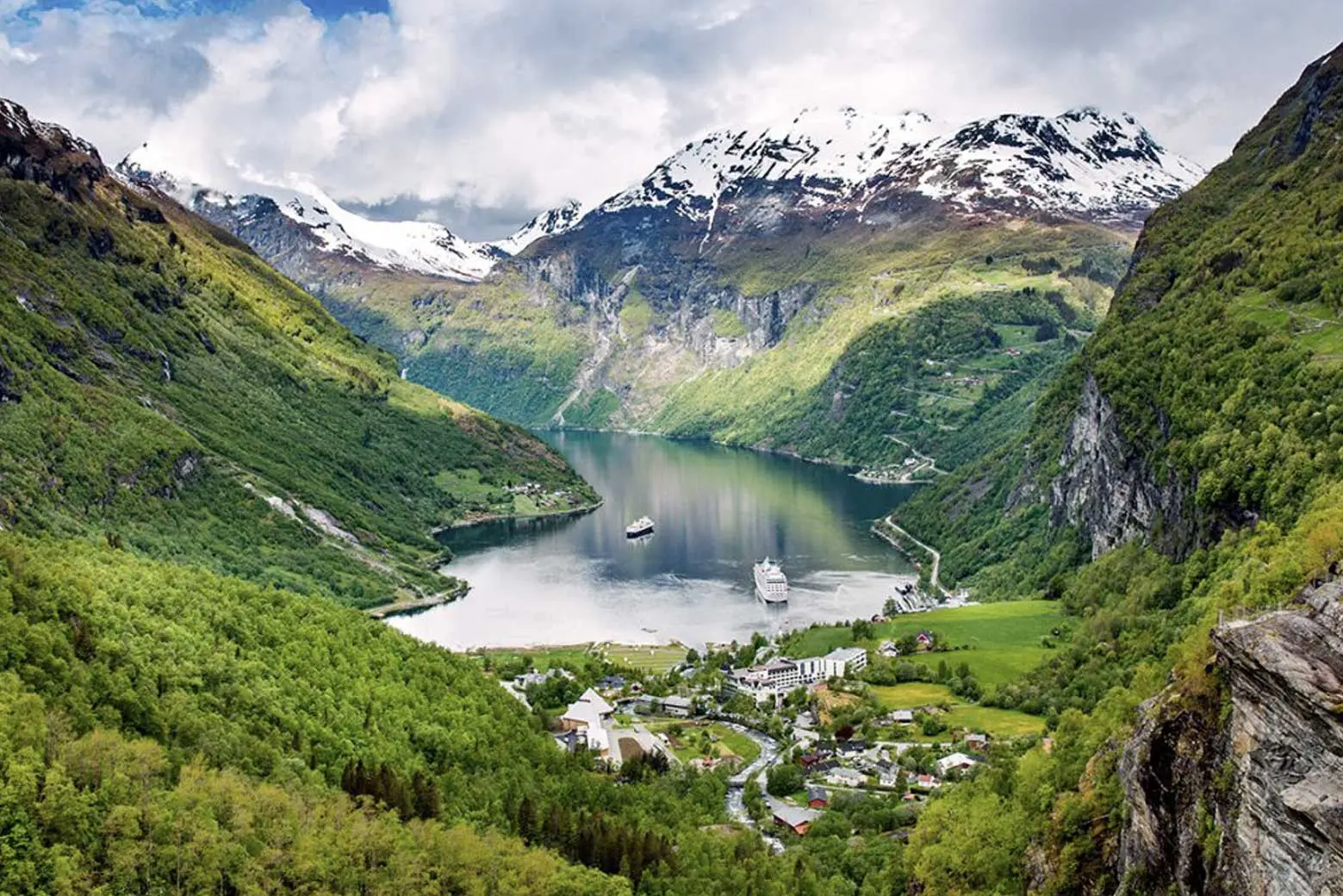
Norway’s mountains with snowed tips and green forest valleys.
